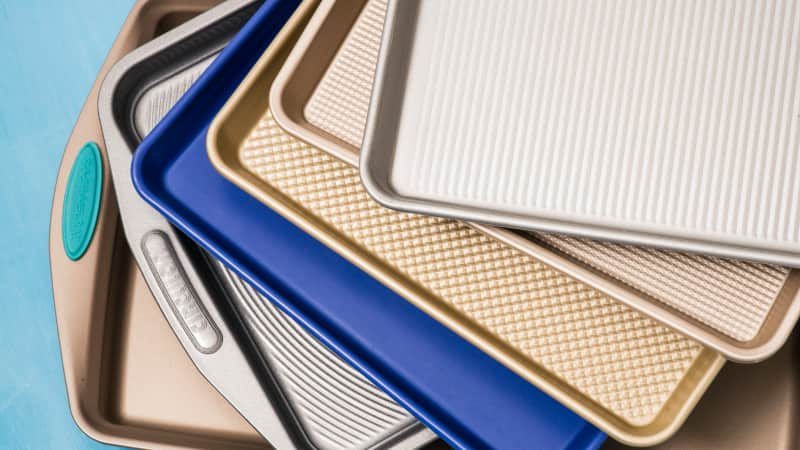Reviews you can trust.
See why.The Best Nonstick Rimmed Baking Sheets
These pans are easy to cook and bake with and even easier to clean. We tested six to find the best one.
Published Feb. 18, 2021.

What You Need To Know
Rimmed baking sheets are some of the most used pans in our kitchens. Nonstick rimmed baking sheets offer many of the same benefits as their traditional counterparts, but they hold special appeal for people who prefer the ease of cooking with and cleaning nonstick equipment. Foods release easily from these pans without the use of parchment paper, silicone mats, or nonstick baking spray. But there’s a trade-off for that convenience: Nonstick cookware shouldn’t go in ovens hotter than 450 degrees or be used under the broiler. You also have to take care when using metal utensils or placing a wire rack inside the pans, as the nonstick coatings can become scratched. While we didn’t think these pans would replace our traditional rimmed baking sheets, we wanted to know if they could still be a useful addition to any kitchen.
We gathered a total of six models, priced from about $16 to about $35. We included pans with smooth cooking surfaces as well as several with textured surfaces. The pans we tested also ranged in color from pale gold to dark silver, and we even included one that was bright blue. We used each pan to bake cookies, roast Parmesan cauliflower, and contain caramel popcorn as it cooled. We examined how evenly the cookies and cauliflower browned and how easily all the foods released from the pans.
Testing Each Pan’s Nonstick Properties
It was difficult to tease out the differences in the pans’ nonstick coatings because all the companies use different terms to describe them. It was simplest to sort them into two categories: coatings that contain polytetrafluoroethylene (PTFE) and those that don’t. PTFE is a chemical component used to make strong, slick, and flexible nonstick coatings, but it can release harmful fumes when exposed to high temperatures. We don’t recommend using cookware with coatings containing PTFE at temperatures above 450 degrees, and some cooks prefer to avoid PTFE altogether. We confirmed with manufacturers that the coatings of five of the six pans in our lineup contained PTFE—including two that are ceramic nonstick, a type of cookware that typically doesn't contain PTFE. The manufacturers of the other pan confirmed that their coatings do not contain PTFE.
Regardless of the type of coating, every pan we tested delivered on its promise to be nonstick. Cookies slid off the pans effortlessly, crispy Parmesan cauliflower was easy to remove, and the sticky caramel popcorn—the most challenging test—released with just a gentle nudge once it had hardened. We didn't have to chisel off food with a spatula or sacrifice some baked-on bits of cheese or cauliflower, as is sometimes the case when we us...
Everything We Tested

Reviews you can trust
Reviews you can trust
The mission of America’s Test Kitchen Reviews is to find the best equipment and ingredients for the home cook through rigorous, hands-on testing. We stand behind our winners so much that we even put our seal of approval on them.

Carolyn Grillo
Carolyn is a senior editor for ATK Reviews. She's a French-trained professional baker.
0 Comments